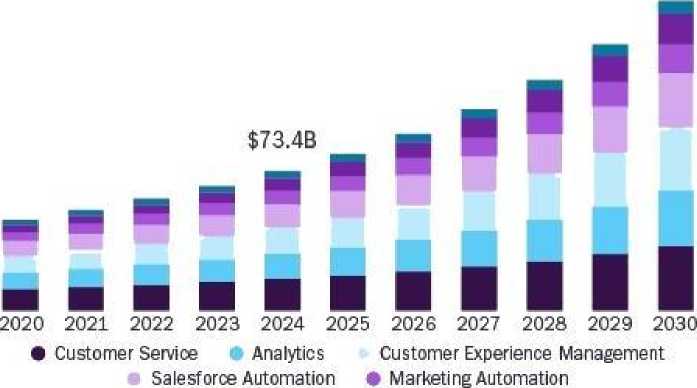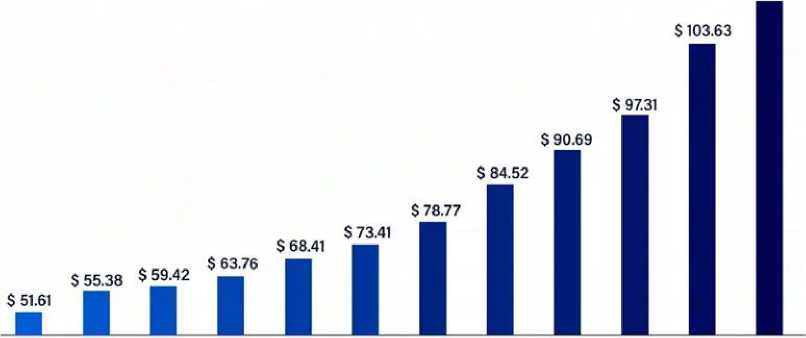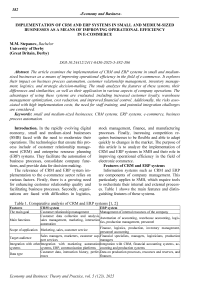Implementation of CRM and ERP systems in small and medium-sized businesses as a means of improving operational efficiency in e-commerce
Автор: M.M. Stepanov
Журнал: Экономика и бизнес: теория и практика @economyandbusiness
Статья в выпуске: 5 (123), 2025 года.
Бесплатный доступ
The article examines the implementation of CRM and ERP systems in small and mediumsized businesses as a means of improving operational efficiency in the field of e-commerce. It explores their impact on business process automation, customer relationship management, inventory management, logistics, and strategic decision-making. The study analyzes the features of these systems, their differences and similarities, as well as their application in various aspects of company operations. The advantages of using these systems are evaluated, including increased customer loyalty, warehouse management optimization, cost reduction, and improved financial control. Additionally, the risks associated with high implementation costs, the need for staff training, and potential integration challenges are considered.
Small and medium-sized businesses, CRM systems, ERP systems, e-commerce, business process automation
Короткий адрес: https://sciup.org/170209254
IDR: 170209254 | DOI: 10.24412/2411-0450-2025-5-382-386
Текст научной статьи Implementation of CRM and ERP systems in small and medium-sized businesses as a means of improving operational efficiency in e-commerce
The relevance of CRM and ERP system implementation to the e-commerce sector relies on various factors. Firstly, there is a growing need for enhancing customer relationship quality and facilitating business processes. Secondly, organizations are faced with difficulties in logistics, stock management, finance, and manufacturing processes. Finally, increasing competition requires businesses to be flexible and able to adapt quickly to changes in the market. The purpose of this article is to analyze the implementation of CRM and ERP systems in SMB and their role in improving operational efficiency in the field of electronic commerce.
Features of CRM and ERP systems
Information systems such as CRM and ERP are components of company management. This particularly applies to SMB, which require tools to orchestrate their internal and external processes. Table 1 shows the main features and distinguishing features of these systems.
Table 1. Comparative analysis of CRM and ERP systems [ 1, 2 ]
|
Features |
CRM system |
ERP system |
|
The main goal |
Customer relationship management |
Management of internal resources of the company |
|
Main functions |
Customer data collection and analysis, sales management, marketing, interaction automation |
Automation of accounting, warehouse accounting, logistics, production management, personnel |
|
Scope of application |
Marketing, sales, customer service |
Finance, logistics, production, inventory management, personnel accounting |
|
Target audience |
Sales managers, marketers, customer support services |
Financial specialists, managers, logisticians, production managers |
|
Integration with other systems |
Integration with marketing automation systems, ERP, communication platforms |
Integration with CRM, financial accounting systems, accounting and production systems |
|
Data type |
Customer data, interaction history, preferences |
Data on production processes, resources and reserves, and finances |
According to the author, the comparative analysis demonstrates that both approaches play an important role in automating various aspects of the company's activities. They can complement each other, providing not only high-quality customer service, but also optimization of business processes within the company.
Application of CRM systems in e-commerce
Modern e-commerce is expanding rapidly, which pushes companies to develop innovative ways to improve customer service standards and enhance the efficiency of business processes. In this context, CRM systems are becoming an important tool for automating customer interactions . As for e-commerce, with constant contact with users through various channels, they allow firms to collect and interpret customer data [ 3 ] . This capability not only allows companies to track buying history and wish lists but anticipate future needs, providing them with instruments for just the appropriate amount of customization of promotional activities. Moreover, aggregation of information from various sources makes it easier to get an overall view of the customer and aid in making better decisions, a determining success criterion in competitive environments.
As per the data gathered, CRM systems permit segmentation and targeting of customers. Segmentation and targeting are processes that involve dividing the base of customers into groups according to demographic characteristics, interests, behavior, and loyalty level. Segmentation enables it to steer marketing more effectively and targeting enables it to offer tailored products and services, which improves the chances of a sale significantly and reduces the cost of advertising campaigns.
Apart from that, automation of sales and marketing campaigns is a very important point in the use of CRM systems for online retail. With their help, businesses are able to launch targeted promotions, mailings, and other actions, automatically tailored based on customer behavior and preferences. In this way, time is freed up for more creative tasks and focusing on strategic business development.
Enhancing the effectiveness of customer communication is one of the main areas of embracing CRM systems for e-commerce. In a competitive market, it is not only speed that counts but also communication quality. With their help, companies can quickly respond to customer requests by updating the status of the order, delivery and other related issues in real time. This significantly improves customer experience, boosts satisfaction levels, and fosters long-term relationships with customers, which are essential for e-commerce success.
A prime example of the widespread adoption of CRM systems is the growing global market for these technologies. According to Grand View Research, it totaled $73,4 billion in 2023 and is expected to continue to increase its compound annual growth rate by 14,6% from 2025 to 2030 (fig. 1).

• Social Media Monitoring • Others
Figure 1. Market size CRM, by platform 2020-2030, billion USD [ 4 ]
This growth is happening in tandem with the global spread of CRM systems and their implementation not only by large enterprises, but also by SMB. In addition, according to statistics, more than 91% of organizations with 11 or more employees use them, which indicates the widespread use of these systems in business operations [ 5 ] . Thus, the indicators of market growth and widespread use of this system by various organizations reflect the usefulness and necessity of implementing such systems to improve the efficiency of the e-commerce business.
Application of ERP systems in e-commerce
Business process automation is among the most important ERP system implementation areas. It is about bringing several enterprise functions together into one information system, which has a profound impact on interdepartmental coordination. The other important aspect is stock management and space planning in the warehouse. This averts firms from facing shortages and overstocking. Goods shortage results in order delay, which can have an adverse impact on customer satisfaction, while overstocking results in warehousing costs. Through the use of ERP, companies can keep records of accurate quantities of inventories, forecast inventory needs based on historical sales and seasonal fluctuations, and have instant action for re-stocking. With this approach, supply and demand equilibrium becomes feasible for companies with the exposure to risk reduced and overall efficiency of operations at a higher level for e-commerce.
Logistics is another important aspect of the ecommerce industry. Systems ERP allow you to automate transportation and delivery procedures, ensuring complete tracking of shipments at every stage of the supply chain. In addition, they can be used to plan optimal delivery routes, which also saves transportation time and logistical costs. They also play an important role in fleet management and vehicle tracking . Their use allows companies to plan maintenance, track fuel costs, and document vehicle depreciation. Moreover, in e-commerce, where the quality delivery service typically is the primary competitive edge, the ability to manage and optimize the logistics process significantly influences company efficiency overall [6].
Financial accounting and cost management are also important for businesses. Systems ERP integrate income and expense data, monitor financial flows in real time, and provide accurate information about the company's current financial condition. This makes it possible to identify potential financial risks in a timely manner and make informed decisions to minimize them [7]. Moreover, the system provides tools for more accurate budget planning, which contributes to better cash flow management.
To e-commerce product manufacturing businesses, ERP systems are needed to automate the production accounting . They allow enterprises to track production stages, material costs, monitor labor resources and equipment usage. Their implementation helps to reduce losses and improve product quality.
Finally, personnel and human resources management is also an integral part of ERP systems. They allow you to automate recruitment, work-time planning, payroll accounting and other staff functions. This frees management from mundane work and allows them to focus on strategic staff management, which helps to improve productivity and improve communication in the organization.
The proof of the widespread use of ERP systems is the rapid growth of their market. In 2023, it was estimated at $51,61 billion and is projected to continue to grow at an annual growth rate of 14,3%. It is expected that by 2034 its volume will reach 110,15 billion dollars (fig. 2).
This trend confirms the growing interest in ERP systems among companies of various sizes, including SMB. Their integration allows to optimize internal processes, which contributes to increasing operational efficiency, reducing costs, and improving resource management.
Features of CRM and ERP system implementation in SMB
The use of CRM and ERP systems offers broad opportunities for growing competitiveness, business expansion, and enhancing management. They integrate various aspects of business, from customer relationships to inner accounting and logistics, which is why they become mandatory tools in modern business. However, despite all their advantages, the process of mastering such systems is fraught with certain risks. One of the main issues is the high price of implementation .
$110.15

2023 2024 2025 2026 2027 2028 2029 2030 2031 2032 2033 2034
Figure 2. Market volume ERP 2023-2034, billion USD [ 8 ]
Apart from the costs of purchasing and installing software, businesses also have to incur extra costs for customizing and integrating with other computer information systems. In addition, careful staff training is required . It can take a lot of time and money to learn to operate the new systems, and insufficient expertise may result in inefficient use. The other risk is that the implementation may fail . Weak system selection, poor business process planning, or integration errors will result in system collapses or failure to produce wanted results.
To prevent risks and unlock the maximum potential of CRM and ERP systems, preparation is necessary. The process starts with business requirements determination and proper system selection. The chosen solution should be in accordance with the size of the business and industry characteristics. For some, basic CRM features will suffice, while other companies may require more advanced, multifunctional solutions with aspects of ERP integrated.
Training and familiarization of employees with the system are essential. The more efficient the staff, the easier and faster the process of adaptation will be. Companies can organize special training programs or hire the services of consultants to train employees to become proficient in all system features. User support at each stage is also required to prevent any potential malfunction and errors.
It should have a definite step-by-step implementation plan that includes an extensive process of integration from installation to com- plete system deployment. Technical aspects should be considered during this process along with workflow details, which are bound to vary. The stages should include testing the system, configuring it, and preparing all business processes that will interact with it. This kind of process enables future errors to be avoided and optimize system usage from the outset.
Once in place, it is necessary to monitor and measure results to determine whether the system is successful. This can be done through key performance indicators such as cost savings, sales growth, or improved customer service speed. This not only helps to monitor results but also allows for adjustments to be made as necessary to optimize system utilization and gain maximum efficiency. Thus, although there are risks, proper utilization of CRM and ERP systems can have the ability to revolutionize company management and drive business growth.
Conclusion
Application of CRM and ERP systems in SMB within the e-commerce sector is an excellent instrument for enhancing business effectiveness and customer interaction. The systems enable business process automation, unification of various company functions, and decision-making based on data. However, despite numerous advantages, application of such systems is dangerous and has risks like high initial expenses, training of employees, and potential integration challenges with existing business processes. Hence, proper implementation needs careful preparation and a properly drawn up step-by-step plan.


